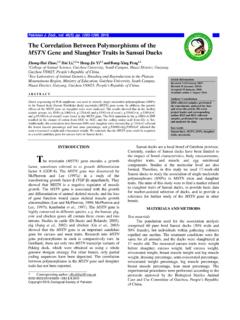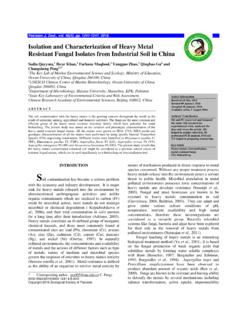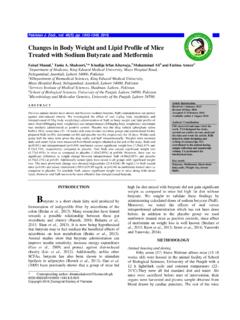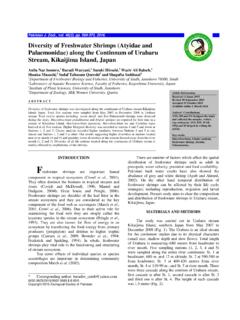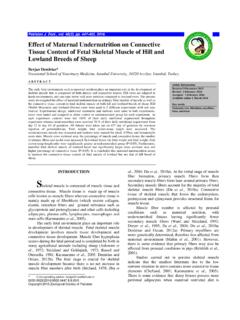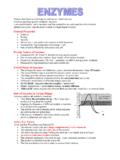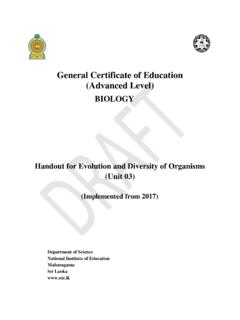Transcription of Biology of Dubas Bug, Ommatissus lybicus (Homoptera ...
1 Pakistan J. Zool., vol. 44(6), pp. 1603-1611, 2012. Biology of Dubas Bug, Ommatissus lybicus ( homoptera : tropiduchidae ), a Pest on Date Palm During Spring and Summer Seasons in Panjgur, Pakistan Arif Shah,1,* Ata-ul-Mohsin,1 Muhammad Naeem,1 Muhammad Farooq Nasir,1 Muhammad Irfan-ul-Haq2 and Zahid Hafeez3 1 Department of Entomology, Pir Mehr Ali Shah Arid Agriculture University, Rawalpindi, Pakistan 2 Department of Plant Pathology, Pir Mehr Ali Shah Arid Agriculture University, Rawalpindi, Pakistan 3 Agriculture Research Institute, Sariab Road, Quetta, Balochistan, Pakistan Dubas bug, Ommatissus lybicus is one of the major sucking pests of date palm. Both nymphs and adults suck the sap from fronds and fruit stalks. Severe infestations cause even death of date palms. Biological parameters of the bug were studied for the four consecutive generations on Kehraba cultivar during spring and summer seasons 2009-2010.
2 The mean fecundity and longevity of male adults of first (spring) generation were significantly lower than that of second (summer) generations 2009-2010. Mean egg laying frequency, adult longevity, incubation and post ovipositional period during 1st and 2nd generation were , , and ; and , , and days, respectively. The mean nymphal development periods were and days in spring and summer generations with no significant difference. On the average, females have longer life duration ( days) than males ( days) under the similar climatic conditions and generations. This bivoltine hibernates and aestivates in the egg stage in fronds during winter and summer and on an average completes total life cycle of 1st and 2nd generation in and days, respectively. Dubas bug passes and % time of life cycle in eggs stage during spring and summer generations, respectively.
3 Keywords: Dubas bug, Ommatissus lybicus , date palm. INTRODUCTION Dubas bug, Ommatissus lybicus (Deberg) Aschae and Wilson ( homoptera : tropiduchidae ) locally known as Sherago is one of the most important sucking pests of date palm in district Panjgur of Pakistan. Infestation of this pest was first reported in 1999 and since then it has become one of the major problems in date palms in Panjgur. It is also considered a major pest of date palm in several countries of Old World (Alfieri, 1933; Klein and Venezian, 1985). It apparently originated in the Tigris-Euphrates river valley (Dowson, 1936). In 1930s, date palm in the Basra regions of Iraq was free of Dubas bug (Dowson, 1936) whereas, in recent past it has been ranked as number one among pests of date palm in Iraq (Heil, 2007) causing economic losses upto 50% (Kranz et al.)
4 , 1978). Whereas according to Gassouma, (2004) in case of heavy infestation, the Dubas bug might reduce the _____ * Corresponding author: 0030-9923/2012/0006-1603 $ Copyright 2012 Zoological Society of Pakistan. crop yield to level less than 50%. Fruits of infested palms are reported to be smaller and to ripen more slowly, with a high percentage of reducing sugar and low percentage of sucrose (Hussain, 1974). In Oman Dubas bug has been considered the most serious pest of date and can even cause the death of tree (Hunter-Jones and Tunstall, 1972). Nymphs (Fig. 1A) and adults (Fig. 1B) of this bivoltine pest cause damage to date palm by sucking the sap from leaflets; midrib of frond and fruit stalks (Hussain, 1963; Lepesme, 1947). In case of heavy infestation, they produce extremely large quantities of honeydew which cover the leaves and support sooty mold that grows on the honeydew and reduces the photosynthetic activities (Mokhtar and Al-Mjeini, 1999; Elwan and Al-Tamiemi, 1999; Gassouma, 2004).
5 Whereas, sooty mold was not observed on palm infested with Dubas bug in the Arava valley, Israel (Klein and Venezian, 1985). Dubas bug has two generations (spring and summer) in a year and it completes whole life cycle of 1st and 2nd generation in frond (Esmaili, 1983; Askari and Bagheri, 2005; Capinera, 2008; Sepanji et al., 2010). In Oman, the emergence of nymphs A. SHAH ET AL. 1604 A B Fig. 1. Ommatissus lybicus ; A, nymph; B, adult. of spring and summer generations takes place in the months of February and August, respectively (Thacker et al., 2003). Al-Mahmooli et al. (2005) on the other hand, reported that the emergence of spring generation takes place in the month of January. Total nymphal development period of spring generation on an average lasts for days. The duration of adult male and female is 82 and 72 days, during which female deposits 143 eggs.
6 This pest hibernates and aestivates in egg stage for 120 and 95 days during spring and summer generation, respectively (Abd-Allah et al., 1998). Owing to the isolated pest population prevalent under adverse climatic conditions and disagreement of different investigators on different biological parameters, this study under the agro-ecosystem of district Panjgur was carried out with the objectives to provide basic information regarding development duration of different life forms, which are necessary to devise an effective management programme for this pest in district Panjgur and similar areas. MATERIALS AND METHODS Biology of Dubas bug ( Ommatissus lybicus ) for four consecutive generations (spring and summer) was studied in district Panjgur (N 26* E 064* , 3200ft) Balochistan, Pakistan during the years 2009 and 2010.
7 Plant materials Kehraba which is one of the major (in term of area) and most susceptible cultivar (against Dubas bug) in this area was selected for this study. Kehraba sucker and mature plant leaflets were used for stock population and fecundity study, respectively. The suckers were grown in earthen pots with a dimension of 2 x 2 x 4 and covered with a muslin cloth, while leaflets were covered in locally made cages at egg laying stage of Dubas bug one season earlier. Suckers were about 4-5 years old at the time of planting. Same suckers were used for the four generations. The suckers were irrigated at weekly intervals and no chemical fertilizer and farm yard manure were applied during the course of experiment. Insect culture After emergence, a number of first instar Dubas bug nymphs were collected from date palm cv.
8 Kehraba and maintained in caged potted plant suckers for mass culture (stock population). In order to note the fecundity (number of eggs/female), a single pair ( and ) of Dubas bug, at 5th nymphal instar were collected from stock population with the help of aspirator and released in a locally made Biology ON Dubas BUG IN SPRING AND SUMMER 1605micro cage of the size of 28 x 305 mm in diameter and length, respectively. In each cage, single leaflet of about two years old (free from eggs infestation) were caged and remained intact with tree during the course of study. Dubas bug pairs were kept in the same cage for the whole adult period. To study the pre-ovipositional, ovipostional and post-ovipositional periods and egg laying frequency (eggs per female/day), a single pair of Dubas bug was confined in circular micro cages of the size 19 x 13 mm diameter containing about two years old leaflets.
9 Each day the circular cages containing Dubas bug pairs were dragged on the same leaflet and circled/marked the caged area with marker to facilitate eggs, counting. After completion of egg deposition and on the death of adults, micro cages were removed from leaflets. Confined leaflets (with eggs) caged in both cages were cut with sharp cutter from frond at base and put into paper envelops and brought to laboratory for counting the above parameters. Some of the infested leaflets remained caged for the purpose to note the hatching time (date/month) and incubation period (days) of first and second generations. During first year, in order to note the emergence of nymphs of spring and summer generations, caged leaflets were observed regularly. Number and duration (days) of each nymphal instar were recorded by caging 0 day old nymphs in circular micro cage.
10 Caged nymphs were monitored daily and exuvae (shaded skin) was recorded for counting number and duration of instars /moults. Adult longevity (both of male and female) was recorded by caging them separately at 5th nymphal instar. Meteorological data The mean temperature (maximum and minimum) and relative humidity data recorded from January to December in 2009-2010 are shown in Figure 4. Statistical analysis The data recorded were analysed using one way ANOVA followed by Duncan s (1955) multiple range test for significance of differences at 5 %. Graphic work was done using Microsoft Excel programme. RESULTS Fecundity Mean fecundity (no. of eggs/female) in spring (1st generation) 2009 was lower ( ) than summer (2nd generation) ( ) 2009, and the same trend continued during spring ( ) and summer ( ) during 2010 respectively (Table I).


